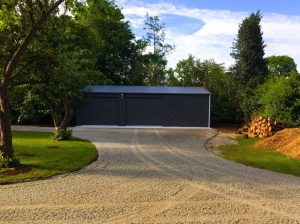
Want to build a chicken coop? Did a cost estimate? Realized you don’t have enough money for it right now? Well if you happen to have a playhouse no one is playing with anymore, you might have just found a solution… like the owner of this old playhouse chicken coop.
She has been wanting to raise chickens for years. The problem is they don’t have the budget for all the materials needed. And even after some time of saving, she still got discouraged by how much she has to spend for lumber!
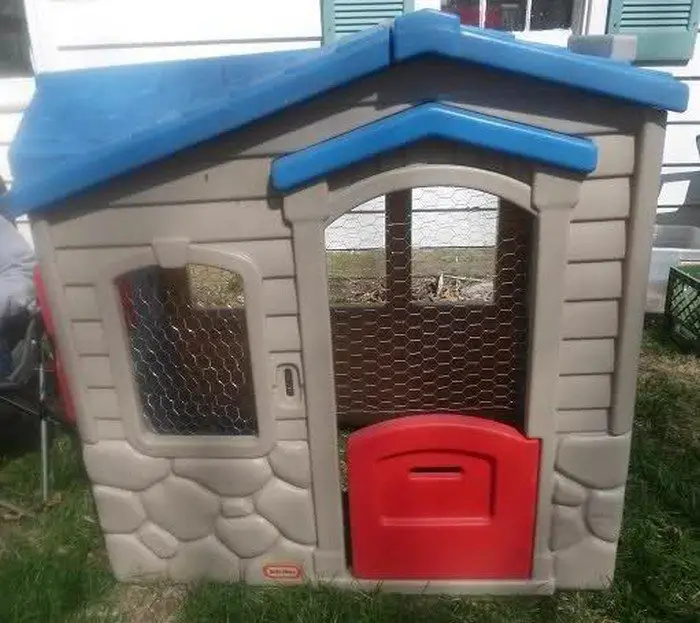
But when she saw their hand-me-down playhouse her children never played with, she had a brilliant idea of repurposing it into a chicken coop. With just a little bit of tweaking and extensions, they now have a home for their backyard chickens!
Poultry raising is a growing trend, and if you want to be a part of this trend you will need a homemade chicken coop. To produce fresh eggs, chickens require a safe environment in which to live. A homemade chicken coop can provide laying hens exactly that. They will also allow your feathered friends some extra sustenance in the form of insects living in the soil.
There are definitely several inexpensive ways to build a chicken coop. These ideas would work depending on your situation. If you have access to really cheap lumber, that maybe a better option for you. You can also try using other old recyclable materials. This old playhouse chicken coop, however, is no doubt the best idea for those who own a playhouse already!
Do you know someone who can use this cheap chicken coop idea?
Contents
Building an Old Playhouse Chicken Coop
Materials
- Old Playhouse
- 2×2, 2×4, 4×4, Timber
- Plywood
- Fender Washers and Screws
- Hardware Cloth
- Paint
- Vent Covers
- Clear Silicone
- Plastic Roofing Sheets
Tools
- Pliers
- Staple Gun
- Cordless Drill
- Paintbrush
- Tin Snips
- Hole Saw
- Caulking Gun
Instructions
Step 1: Assess and Prepare the Playhouse
- Inspect the old playhouse for any damages. Repair with plywood and timber as necessary.
- Clean the playhouse thoroughly to ensure it is free from contaminants and pests.
Step 2: Design Your Layout
- Plan where you will place the door, windows, nesting boxes, and roosting bars. Consider the natural light and wind direction for placement of vents.
Step 3: Secure the Structure
- Reinforce the base of the playhouse using 2×4 and 4×4 timbers to ensure it can support the weight and activity of your chickens.
- Use the cordless drill and screws to secure the timber in place.
Step 4: Add Nesting Boxes and Roosts
- Construct nesting boxes using plywood. Attach them to the interior walls with screws.
- Install roosting bars across the interior. Ensure they are secure and spaced appropriately for the chickens to perch comfortably.
Step 5: Install Ventilation
- Use the hole saw to cut openings for ventilation. Install vent covers to keep out pests and protect from the elements.
- Seal around the vents with clear silicone to prevent drafts.
Step 6: Attach Hardware Cloth
- Cut hardware cloth with tin snips to cover windows and any openings. This keeps predators out while allowing good air circulation.
- Attach the hardware cloth using the staple gun and secure it with fender washers and screws.
Step 7: Weatherproofing
- Measure and cut plastic roofing sheets to cover the existing roof for additional waterproofing.
- Secure the roofing sheets with screws, and seal the edges with clear silicone using the caulking gun.
Step 8: Painting and Finishing Touches
- Paint the exterior and interior of the playhouse to provide additional weather protection and to make it aesthetically pleasing.
- Use a paintbrush for detailed areas to ensure all nooks and crannies are covered.
Step 9: Final Inspection and Setup
- Inspect the coop to ensure all materials are secure, and there are no sharp edges or loose hardware cloth.
- Set up water and feed containers inside the coop.
Step 10: Introduce Your Chickens
- Once everything is set and dry, introduce your chickens to their new home.
Click on any image to start lightbox display. Use your Esc key to close the lightbox.![]()

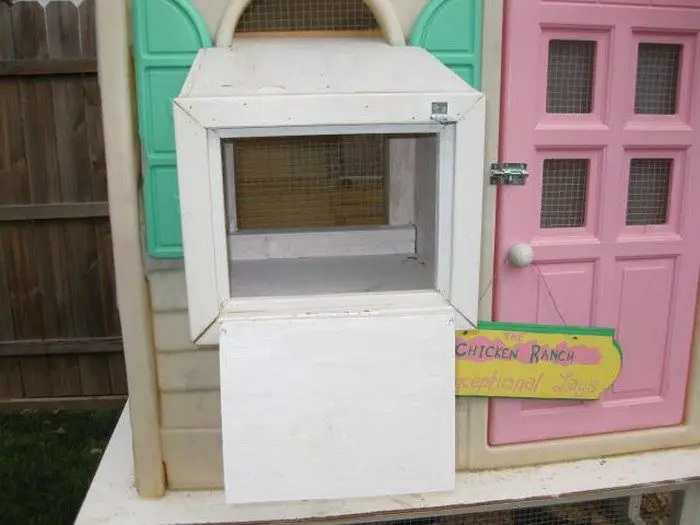
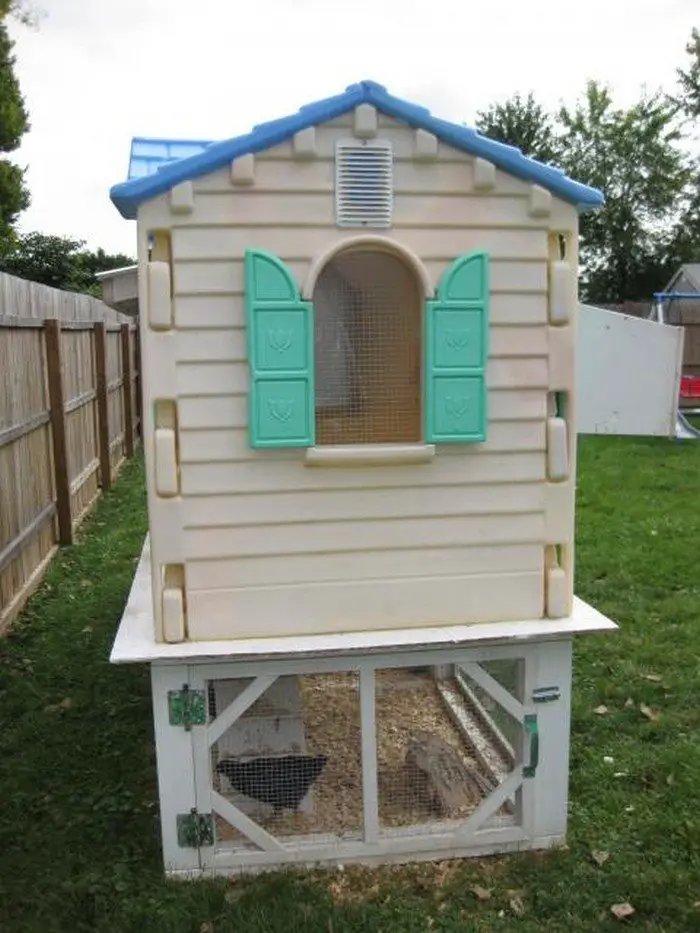
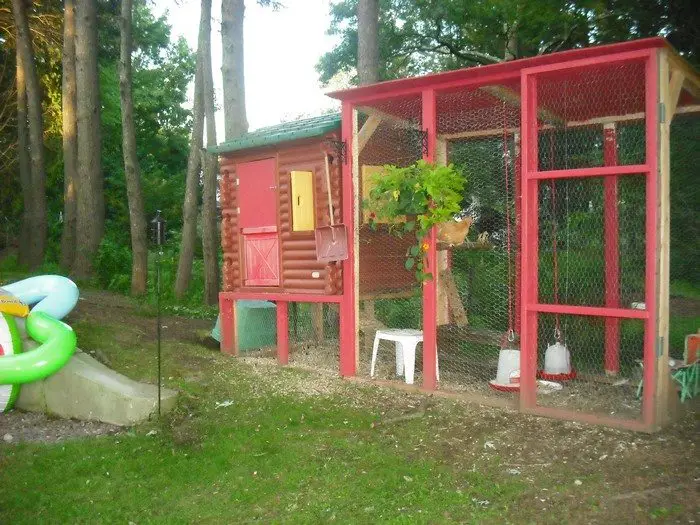
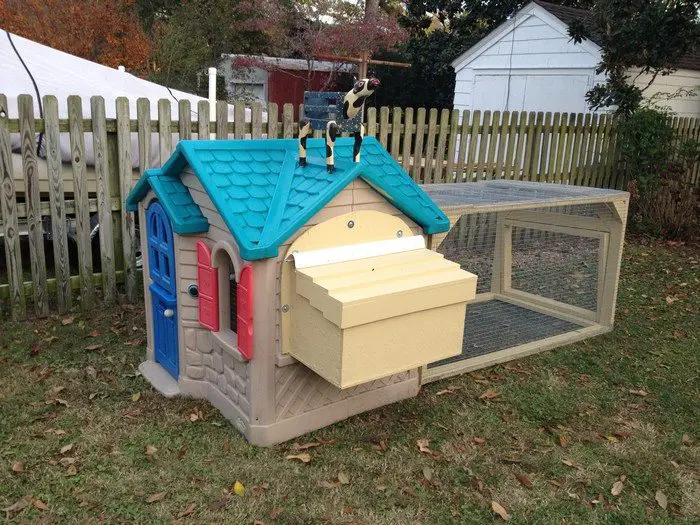

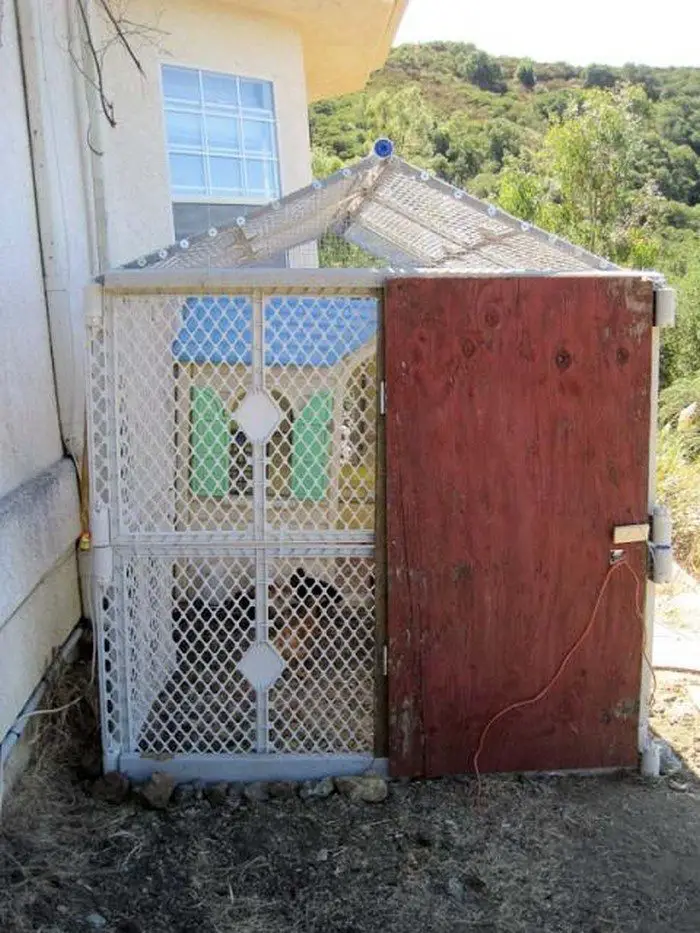
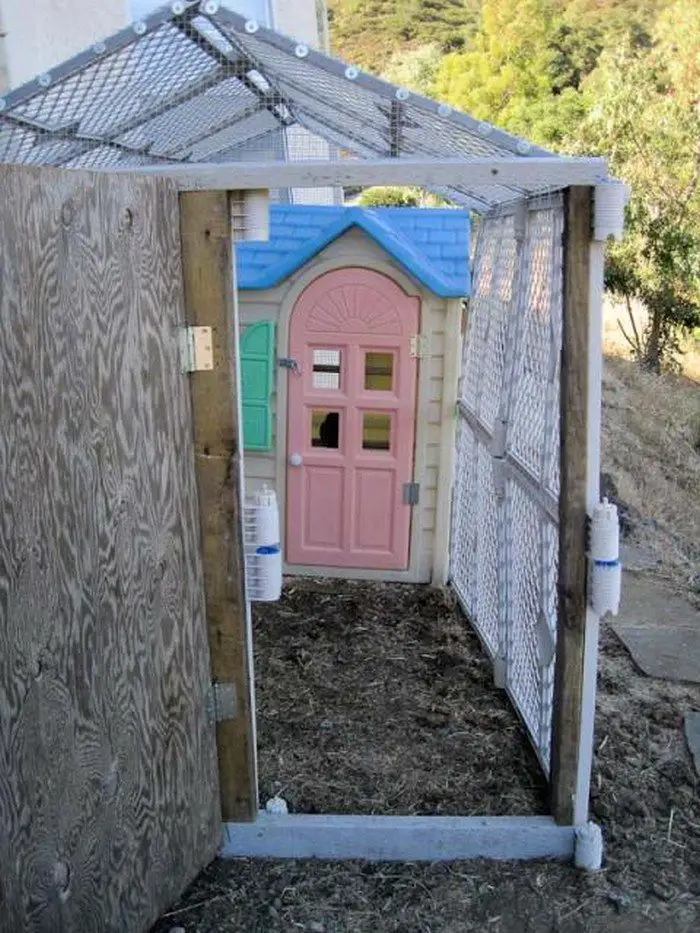
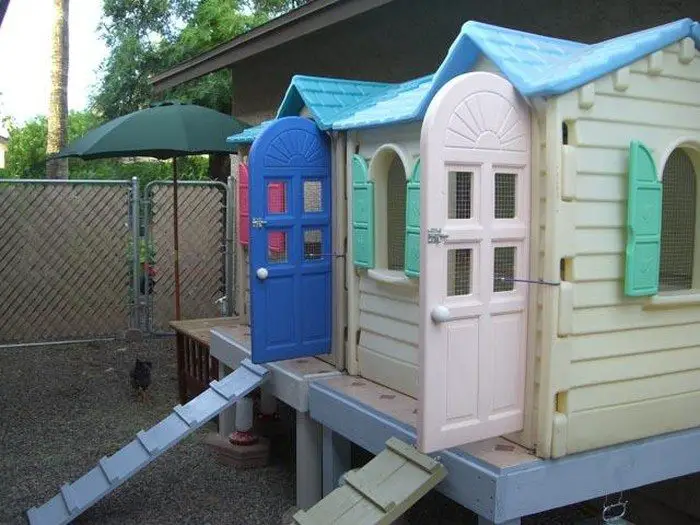



You can get more step-by-step instructions here…
Design Modifications for Optimal Chicken Health
Transforming an old playhouse into a chicken coop is not just about repurposing; it’s about creating a healthy and safe environment for your chickens. Certain design modifications are crucial to ensure optimal health and well-being for your feathered friends.
Here, we explore essential adjustments to make your old playhouse chicken coop a perfect home for chickens.
Enhanced Ventilation
Proper ventilation is critical in maintaining air quality and controlling the temperature within the old playhouse chicken coop. Install adequate vent covers on multiple sides of the playhouse to ensure cross ventilation.
This will help reduce ammonia levels from the droppings and keep the coop dry and free from mold and mildew. Strategic placement of these vents at both high and low points encourages natural air flow without causing drafts at ground level where the chickens roost.
Predator-Proofing
Safety from predators is paramount for chicken health. Reinforce the old playhouse chicken coop by covering all windows and openings with hardware cloth instead of chicken wire, which is less durable. Secure the edges with screws and fender washers to prevent predators from prying them open. Additionally, ensure the playhouse’s door has a sturdy lock to keep out unwanted visitors.
Insulation for Temperature Control
Chickens are sensitive to extreme temperatures. Insulating the walls of the old playhouse chicken coop can help regulate the internal temperature. Use plywood to line the interior walls, and seal gaps with clear silicone to prevent drafts. In colder climates, consider adding extra layers of insulation material between the plywood and the playhouse walls.
Easy-to-Clean Surfaces
Maintaining cleanliness in the old playhouse chicken coop is essential for preventing diseases. Paint the interior surfaces of the old playhouse chicken coop with a non-toxic, washable paint.
This creates a moisture-resistant barrier that makes cleaning easier and prevents parasites such as mites and lice from inhabiting the wood. Slope the floor slightly towards the door to facilitate washing out and drainage.
Comfortable Roosting and Nesting Areas
Proper roosting bars and nesting boxes are vital for the comfort and well-being of chickens. Install roosting bars that are wide enough for the chickens to comfortably sit and balance on without injuring their feet.
Nesting boxes should be spacious and filled with soft bedding material to encourage laying. Position these boxes in a darker, more secluded part of the old playhouse chicken coop to provide privacy and security for the laying hens.
Your old playhouse chicken coop will be a useful area as well as a healthy and happy place for your chickens if you make some design changes. These modifications guarantee that your coop promotes your chickens’ psychological and physical health, which eventually results in a more fulfilling and productive backyard farming experience.
Cost Analysis and Budget Tips
Converting an old playhouse into a chicken coop is an economical and sustainable option for backyard chicken enthusiasts. It allows you to repurpose a structure that might otherwise go unused, while saving on the costs of building a new coop from scratch.
Here’s a detailed cost analysis and some budget tips to help you make the most of your old playhouse chicken coop project without breaking the bank.
Initial Cost Evaluation
The primary cost advantage of converting an old playhouse into a chicken coop lies in reusing existing materials. The main expense will be in modifying and reinforcing the playhouse to make it suitable for chickens.
Costs can vary widely depending on the condition of the playhouse and the materials you already have at hand. Assess the structure for potential repairs and list the materials needed for modifications like additional timber, hardware cloth, and roofing.
Material Sourcing
- Recycle and Reuse: Utilize as much existing material from the old playhouse as possible. For any additional materials required, consider visiting reclaim yards or using surplus from other projects.
- Purchase Wisely: For items that need to be purchased new for your old playhouse chicken coop, such as screws or paint, shop around for the best deals. Bulk purchases can sometimes lead to discounts, and local hardware stores may offer competitive prices compared to big chains.
DIY to Save
One of the biggest cost savers in converting an old playhouse into a chicken coop is doing the work yourself. Hiring professionals can significantly increase the project budget. If you are not confident in your DIY skills for certain tasks, like electrical work for adding lighting, seek help from friends or family who may have the necessary skills and can assist for less than the cost of professional services.
Borrow Instead of Buy
For tools that you do not own, consider borrowing from neighbors or renting from local hardware stores instead of purchasing them. This can significantly cut down costs, especially for one-time-use tools like a caulking gun or a hole saw when building your old playhouse chicken coop.
Plan for Contingencies
Always allocate an additional 10-15% of your total estimated budget for unforeseen expenses on your old playhouse chicken coop. Whether replacing a broken tool or needing extra materials, having a contingency budget can help keep your project on track without additional financial stress.
Cost-Effective Enhancements
Think about long-term savings when considering enhancements. For example, investing in high-quality paint for the old playhouse chicken coop can prevent frequent reapplications and reduce maintenance costs over time.
With smart budgeting and resource management, you can convert an old playhouse into an attractive and useful chicken coop for relatively little money. By giving old structures new uses, this idea not only saves money but also promotes sustainable living.
Conclusion
Transforming an old playhouse into a chicken coop is a creative and cost-effective way to provide a safe, comfortable home for your chickens. This project not only repurposes unused structures but also adds a charming feature to your backyard. With the right modifications and materials, your old playhouse chicken coop will become a sustainable haven for your feathered friends.

